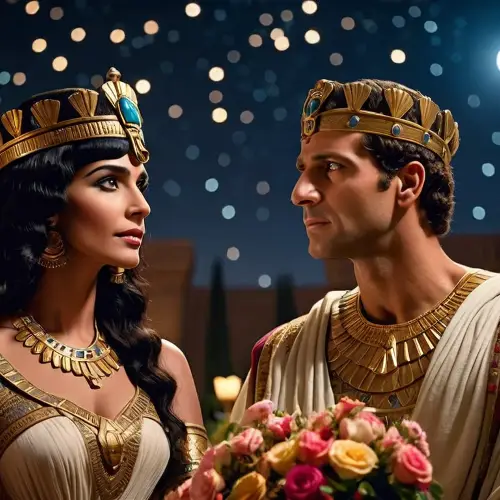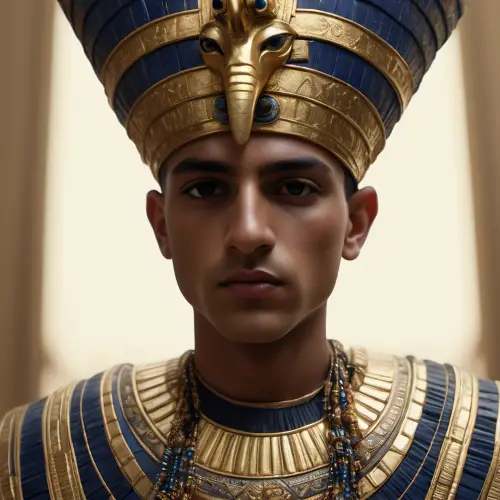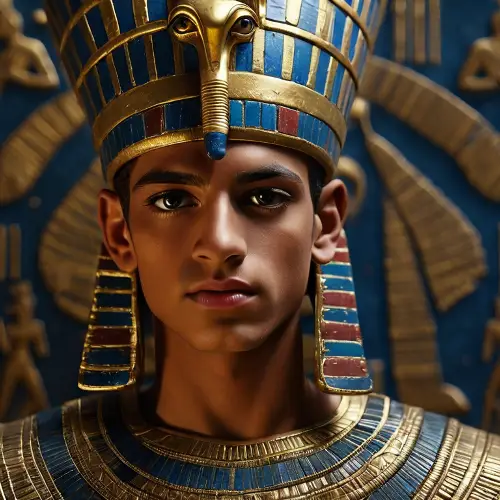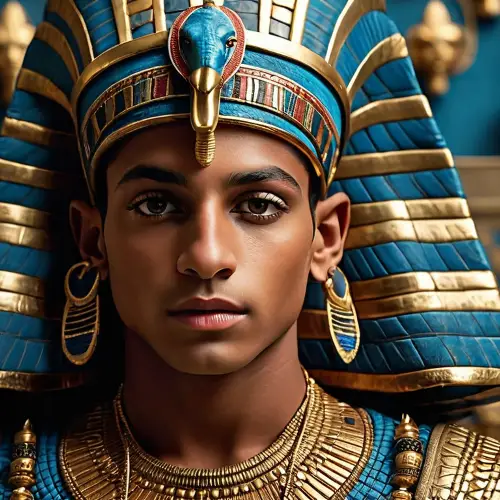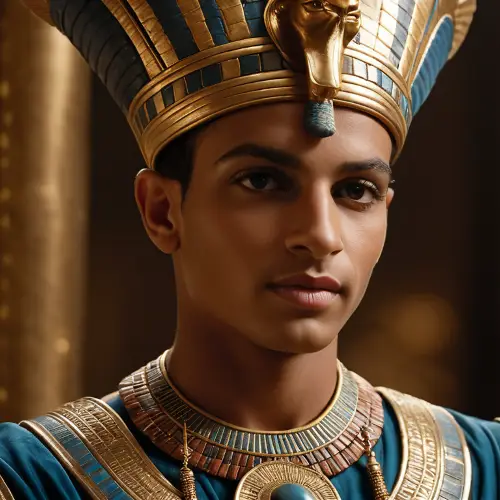In the vibrant spring of 51 BCE, bathed in the warm glow of sunlight, the young Ptolemy XIII assumes his fathers mantle as the Pharaoh of Egypt. His face, a mixture of youthful innocence and the weight of responsibility, reveals the essence of a burgeoning leader.Seated beside him on the throne, Cleopatra, his sister and co-ruler, the epitome of regal grace, signifies unity and strength. Their marriage becomes a symbol of power and consolidation, promising to guide Egypts destiny hand in hand. The scene encapsulates the tender moment of an alliance, where two hearts, still in their formative years, pledge to grow together.
More Like This
In the resplendent halls of Alexandria, Cleopatra, adorned in regal attire, ascends the throne alongside her son, Ptolemy XV Philopator Philometor Caesarion, a mere thirteen years old. The room, adorned with opulent Egyptian decor, bears witness to the historic moment of succession.Cleopatras face reflects a blend of maternal pride and sovereign determination as she places the diadem on her young sons head. The air is charged with a sense of continuity and the promise of a new era as Cleopatra, with graceful authority, establishes her son as the heir to the throne. The scene captures the essence of a queen securing the legacy of her lineage.
In the intricate corridors of the royal court, a subtle dance unfolds between Ptolemy and Cleopatra, heirs to the throne. Clad in the regalia of power, they navigate a delicate balance of competition and cooperation, their relationship marked by the shadows of rivalry.Ptolemy, steadfast and ambitious, seeks to assert his authority as the rightful heir. Meanwhile, Cleopatra, equally determined, employs her wit and charm to garner support and carve her own path to influence. The air is charged with the tension of a dynastic struggle, where each move and alliance shapes the destiny of Egypts rulership.
In the grandeur of the Egyptian palace, Cleopatra, draped in regal attire, stands beside her young son, Ptolemy XV Philopator Philometor Caesarion. The room, adorned with symbols of ancient Egypt, bears witness to the historic moment as Cleopatra ensures a smooth transition of power.Cleopatras face reflects a mix of maternal pride and sovereign grace as she ceremoniously presents the young heir before the courtiers. The air is charged with the weight of responsibility and the promise of a new reign. The scene captures the essence of a queen securing the future, entrusting her son with the legacy of Egypt.
In the grandeur of the Egyptian palace, Cleopatra, draped in regal attire, stands beside her young son, Ptolemy XV Philopator Philometor Caesarion. The room, adorned with symbols of ancient Egypt, bears witness to the historic moment as Cleopatra ensures a smooth transition of power.Cleopatras face reflects a mix of maternal pride and sovereign grace as she ceremoniously presents the young heir before the courtiers. The air is charged with the weight of responsibility and the promise of a new reign. The scene captures the essence of a queen securing the future, entrusting her son with the legacy of Egypt.
In the grandeur of the Egyptian palace, Cleopatra, draped in regal attire, stands beside her young son, Ptolemy XV Philopator Philometor Caesarion. The room, adorned with symbols of ancient Egypt, bears witness to the historic moment as Cleopatra ensures a smooth transition of power.Cleopatras face reflects a mix of maternal pride and sovereign grace as she ceremoniously presents the young heir before the courtiers. The air is charged with the weight of responsibility and the promise of a new reign. The scene captures the essence of a queen securing the future, entrusting her son with the legacy of Egypt.
In the golden halls of Alexandria, Cleopatra, adorned in royal garments, solemnly presents her 3-year-old son, Caesarion, as the co-ruler Pharaoh Ptolemy XV. The room, adorned with symbols of Egyptian majesty, becomes the stage for a pivotal moment in history.Cleopatras face reflects a mix of maternal tenderness and regal authority as she places the diadem on the young Caesarions head. The air is charged with the promise of a new era as mother and son, in a poignant tableau, embody the continuity of Egypts lineage. The scene captures the essence of a queen securing her sons legacy and entrusting him with the weighty mantle of rulership.
In the golden halls of Alexandria, Cleopatra, adorned in royal garments, solemnly presents her 3-year-old son, Caesarion, as the co-ruler Pharaoh Ptolemy XV. The room, adorned with symbols of Egyptian majesty, becomes the stage for a pivotal moment in history.Cleopatras face reflects a mix of maternal tenderness and regal authority as she places the diadem on the young Caesarions head. The air is charged with the promise of a new era as mother and son, in a poignant tableau, embody the continuity of Egypts lineage. The scene captures the essence of a queen securing her sons legacy and entrusting him with the weighty mantle of rulership.
In the golden halls of Alexandria, Cleopatra, adorned in royal garments, solemnly presents her 3-year-old son, Caesarion, as the co-ruler Pharaoh Ptolemy XV. The room, adorned with symbols of Egyptian majesty, becomes the stage for a pivotal moment in history.Cleopatras face reflects a mix of maternal tenderness and regal authority as she places the diadem on the young Caesarions head. The air is charged with the promise of a new era as mother and son, in a poignant tableau, embody the continuity of Egypts lineage. The scene captures the essence of a queen securing her sons legacy and entrusting him with the weighty mantle of rulership.
In the opulent halls of Cleopatras palace, a momentous occasion unfolds as Cleopatra, radiant in regal attire, stands before a gathered assembly. Her son, Caesarion, stands beside her, the embodiment of a future ruler.Cleopatra, with a proud and loving expression, places a golden crown on Caesarions head, symbolizing his ascent to power. The courtiers and nobles look on with reverence and anticipation. The room is adorned with rich tapestries and intricate Egyptian motifs, echoing the grandeur of the occasion as the young ruler assumes his role under the watchful guidance of his queen mother.
In a grand ceremonial hall adorned with symbols of ancient Egypt, Cleopatra, dressed in resplendent attire, ascends to a raised platform. Surrounded by priests, courtiers, and dignitaries, she raises a jeweled scepter, symbolizing her authority, and declares herself the embodiment of Egypts divine essence.The room is bathed in the warm glow of flickering torches, casting a regal aura around Cleopatra. Hieroglyphs and depictions of Egyptian deities adorn the walls, emphasizing the sacred nature of the moment. The assembled crowd bows in reverence as Cleopatra, with unwavering confidence, declares her role as Egypts goddess and pharaoh.
In the grandeur of Alexandria, Cleopatra, now 18 years old, stands poised on the precipice of her reign. Adorned in regal attire that blends Egyptian and Hellenistic influences, she exudes an air of confidence and grace beyond her years.The room, rich with symbols of power, bears witness to Cleopatras maturation into a formidable leader. Her eyes, a reflection of wisdom and determination, hint at the challenges and triumphs that lie ahead. The scene captures the young queen on the cusp of her rule, ready to navigate the complexities of governance with both strength and sophistication.
Cleopatra is seated at the center, elegantly poised, with Caesar on one side and Antony on the other. Cleopatra sits gracefully, Caesar stands with authority, and Antony gazes at her passionately. Their attire reflects their origins and status, and the background harmoniously combines elements from both Rome and Egypt, symbolizing the intricate relationships of love and politics among them.
Positioned on an elevated stage in the heart of Alexandria, Cleopatra stands with her back to the vast assembly of citizens, her silhouette commanding attention. The crowd, a sea of diverse faces and colorful attire, gathers in rapt anticipation, facing Cleopatra as a symbol of hope and leadership.As the queen addresses her people, the sun sets behind her, casting a warm glow on the scene. The air is filled with a sense of unity and purpose, captured by the collective gaze of the attentive citizens. Cleopatras presence, though seen from behind, emanates strength and determination, symbolizing a leader deeply connected to her people.
Cleopatra sits in the serene palace garden, gazing up at the dark night sky where stars twinkle in her eyes. On one side stands the Roman Emperor, and on the other, the King of Egypt, both looking towards Cleopatra. Their faces reflect emotions for each other, and in Cleopatra’s hand, there are adorned flowers and a crown. This moment captures a beautiful scene of love and destiny between Cleopatra and the two kings.
Cleopatra is positioned at the center, with the Roman Emperor on one side and the Egyptian King on the other. Cleopatra and the Roman Emperor exchange intense gazes while engaging in conversation, while Cleopatra and the Egyptian King face each other, symbolizing their unique relationship. Each character’s distinctive attire and surroundings emphasize their origins and roles. Arranged in the form of a triangle, this image captures the complexity and emotional depth of love and political connections
Cleopatra is positioned at the center, with the Roman Emperor on one side and the Egyptian King on the other. Cleopatra and the Roman Emperor exchange intense gazes while engaging in conversation, while Cleopatra and the Egyptian King face each other, symbolizing their unique relationship. Each character’s distinctive attire and surroundings emphasize their origins and roles. Arranged in the form of a triangle, this image captures the complexity and emotional depth of love and political connections
Cleopatra is positioned at the center, with the Roman Emperor on one side and the Egyptian King on the other. Cleopatra and the Roman Emperor exchange intense gazes while engaging in conversation, while Cleopatra and the Egyptian King face each other, symbolizing their unique relationship. Each character’s distinctive attire and surroundings emphasize their origins and roles. Arranged in the form of a triangle, this image captures the complexity and emotional depth of love and political connections
Cleopatra is positioned at the center, with the Roman Emperor on one side and the Egyptian King on the other. Cleopatra and the Roman Emperor exchange intense gazes while engaging in conversation, while Cleopatra and the Egyptian King face each other, symbolizing their unique relationship. Each character’s distinctive attire and surroundings emphasize their origins and roles. Arranged in the form of a triangle, this image captures the complexity and emotional depth of love and political connections
A youthful Tutankhamun, Pharaoh of Egypt, portrayed in his early years. He stands with regal grace, adorned in ornate garments reflecting the opulence of ancient Egyptian royalty. The intricate details of his attire and the grandeur of his headdress symbolize the power and splendor of his reign.
A youthful Tutankhamun, Pharaoh of Egypt, portrayed in his early years. He stands with regal grace, adorned in ornate garments reflecting the opulence of ancient Egyptian royalty. The intricate details of his attire and the grandeur of his headdress symbolize the power and splendor of his reign.
In the heart of Alexandria, the echoes of a tumultuous sibling rivalry resound as Ptolemy and Cleopatra find themselves entangled in a fierce dynastic conflict. The palace, once a symbol of unity, becomes the battleground for their internal strife.Ptolemy, fueled by ambition, rallies supporters among the courtiers, while Cleopatra, resolute and strategic, garners alliances to secure her claim. The air is thick with tension as political maneuvers clash with familial bonds, and the once-unified kingdom stands at the precipice of internal discord. The scene captures the poignant moment when familial ties unravel, leaving a kingdom teetering on the brink of internal strife.
Standing atop a grand podium in the heart of Alexandria, Cleopatra, regal and poised, addresses her people with eloquence. The sprawling crowd gathers in awe, draped in vibrant fabrics that mirror the diverse tapestry of ancient Egypt.The sun sets, casting a warm glow on Cleopatra as she speaks, emphasizing her commitment to unity and progress. Banners bearing symbols of prosperity flutter in the breeze, and the air is filled with the anticipation of positive change. The scene captures a moment of collective inspiration as Cleopatra, with charisma and authority, articulates her vision for a flourishing and harmonious Egypt.
Born in Cleopatras arms, the twins and sisters were beautifully blended together like stars shining under the blue sky. The son had a warm smile like sunshine, and the daughter was smiling seductively like an elegantly unfolded flower. Their serene eyes capture the unique Egyptian mystery, and their sun-stained skin symbolically reflects the splendid legacy of ancient civilization.
Within the opulent halls of Alexandria, the simmering tension between Ptolemy and Cleopatra reaches a boiling point, casting a shadow over their once-unified kingdom. The room, adorned with the remnants of familial unity, becomes the stage for a bitter confrontation.Ptolemys face contorts with determination, fueled by ambition and resentment, while Cleopatra, her regal demeanor strained, counters with unwavering resolve. The air is charged with the palpable animosity as sibling rivalry transforms into open conflict. The scene captures the anguished expressions of anger and betrayal, marking a tragic chapter in the unraveling saga of the Ptolemaic dynasty.
Cleopatra, adorned in regal attire, cradles her newborn son, Caesarion, in her arms. The room is bathed in a soft, golden glow from flickering candles, casting a warm ambiance. Caesar, with a proud and tender expression, stands by Cleopatras side, witnessing the arrival of their heir. The air is filled with a sense of anticipation and joy as they welcome the newest member of their royal family.
Amidst the splendor of Alexandria, Julius Caesar, the revered Roman general, finds himself captivated by the enchanting beauty of Cleopatra. The setting sun bathes the scene in warm hues as the queen, draped in regal attire, captures Caesars attention.Cleopatras allure is undeniable, her features illuminated by the fading daylight. The air is infused with a subtle tension as Caesar, entranced by her presence, succumbs to the magnetic pull of her charisma. The scene captures the moment when Cleopatras beauty casts a spell on the formidable Roman leader, setting the stage for an entwined destiny.
In the fertile fields of the Nile Delta, Cleopatra orchestrates a visionary agricultural reform. Dressed in regal attire, she stands amidst the vibrant crops, overseeing the implementation of innovative farming techniques.The once traditional landscape transforms under Cleopatras guidance, with advanced irrigation systems and crop rotation practices enhancing productivity. Skilled farmers, inspired by the queens vision, cultivate diverse crops, symbolizing a harmonious blend of ancient Egyptian traditions and forward-thinking approaches. The scene captures the essence of Cleopatras agricultural revolution, fostering prosperity across the kingdom.
In a sunlit chamber adorned with scrolls and hieroglyphics, young Cleopatra, at the tender age of 7, sits earnestly with papyrus and quill, engaging in her studies. The room, echoing with the soft rustle of papyrus and the scent of ancient knowledge, becomes the backdrop for a scene of early intellectual curiosity.Cleopatra, in simple yet elegant attire, gazes intently at her lessons, guided by tutors who impart the wisdom of ancient Egypt. The air is filled with a sense of potential as the young princess embraces the pursuit of knowledge. This scene captures a snapshot of Cleopatras formative years, where the seeds of her future brilliance are sown through the blossoming of her inquisitive mind.
In a sunlit chamber adorned with scrolls and hieroglyphics, young Cleopatra, at the tender age of 7, sits earnestly with papyrus and quill, engaging in her studies. The room, echoing with the soft rustle of papyrus and the scent of ancient knowledge, becomes the backdrop for a scene of early intellectual curiosity.Cleopatra, in simple yet elegant attire, gazes intently at her lessons, guided by tutors who impart the wisdom of ancient Egypt. The air is filled with a sense of potential as the young princess embraces the pursuit of knowledge. This scene captures a snapshot of Cleopatras formative years, where the seeds of her future brilliance are sown through the blossoming of her inquisitive mind.
In a sunlit chamber adorned with scrolls and hieroglyphics, young Cleopatra, at the tender age of 7, sits earnestly with papyrus and quill, engaging in her studies. The room, echoing with the soft rustle of papyrus and the scent of ancient knowledge, becomes the backdrop for a scene of early intellectual curiosity.Cleopatra, in simple yet elegant attire, gazes intently at her lessons, guided by tutors who impart the wisdom of ancient Egypt. The air is filled with a sense of potential as the young princess embraces the pursuit of knowledge. This scene captures a snapshot of Cleopatras formative years, where the seeds of her future brilliance are sown through the blossoming of her inquisitive mind.
Within the expansive halls of Cleopatras palace, the queen passionately addresses a diverse gathering of scholars, architects, priests, and merchants. Adorned in garments that blend Egyptian and Hellenistic influences, Cleopatra articulates her vision for comprehensive reforms across agriculture, commerce, architecture, and religion.The scene unfolds against the backdrop of an ancient Egyptian setting, with symbols of fertility, trade, and spirituality adorning the surroundings. Maps and architectural plans are spread across tables, illustrating Cleopatras forward-thinking initiatives. The ambiance is one of intellectual exchange and collaboration, symbolizing the queens commitment to advancing her kingdom across multiple domains.
In the sprawling gardens of Alexandria, Marcus Antonius, from a distance, observes Cleopatra with a gaze filled with a potent mix of admiration and longing. Dressed in the regalia of a Roman general, he stands amidst the vibrant foliage, his eyes fixed on the queen.Cleopatra, unaware of his presence, is surrounded by the beauty of the botanical haven. The soft breeze carries a sense of anticipation as the scene encapsulates the silent dance of emotions between the two. The distance between them becomes a poignant canvas, portraying the complexities of a love that transcends boundaries.





























